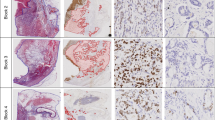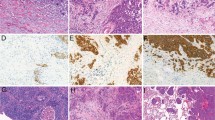Abstract
One hundred and thirty-seven lung cancer patients (123 non-small-cell lung cancers (NSCLC), 10 small-cell lung cancers (SCLC) and four carcinoid tumours) who underwent surgery in an attempt at complete resection were prospectively entered in a study whose aim was to determine the prognostic significance of a hypodiploidy or a multiploidy pattern of tumour cell DNA content and a high immunohistochemical reactivity of Ki-67, a nuclear antigen related to the cell cycle. Indirect immunoperoxidase reactivity of Ki-67 on frozen tumour tissue sections was evaluated both visually, using a classical semiquantitative scale, and by means of a computer-assisted image processor. Cell DNA content analysis was done using static computer-assisted cytometry on tumour cytological prints stained by the pararosaline Feulgen-Schiff technique. The ploidy was characterised for each tumour by DNA index (DI), percentage of hypodiploid cells and type of DNA content histogram (near diploid, hyperdiploid, hypodiploid and multiploid). Ki-67 immunostaining was negative in 64 tumours (48%) and positive in 69 (52%). DNA histogram classification disclosed 57 (42%) near diploid tumours. Among the 80 (58%) aneuploid tumours, 16 were hypodiploid, 44 hyperdiploid and 20 multiploid. The prevalence of both a positive Ki-67 immunostaining and an aneuploid DNA histogram differed according to histology as SCLC demonstrated a higher frequency of both features when compared with NSCLC and carcinoid tumours. On the other hand, Ki-67 immunostaining and ploidy did not significantly differ according to degree of differentiation, nodal status and Mountain's stage grouping. The percentage of cells in the hypodiploid modal DNA was significantly higher for tumours which demonstrated a high Ki-67 immunostaining, suggesting a link between growth fraction and DNA content abnormalities. In univariate analysis, survival did not differ significantly according to either the Ki-67 immunohistochemical reactivity or the DNA index. Patients with a hypodiploid tumour had a shorter survival than patients with other DNA histogram patterns but, owing to the low frequency of hypodiploidy, this difference did not reach statistical significance. In Cox's proportional hazard model, an SCLC histology, an advanced tumour status, a positive nodal status and a hypodiploid tumour (hazard ratio: 2.070; 95% confidence interval 1.041-4.116) were significant determinants of survival. We conclude that hypodiploidy in lung cancer is a distinct DNA content abnormality as it contributes significantly to prognosis. Neither visually assessed nor computer-generated Ki-67 immunostaining measurements significantly determine prognosis.
This is a preview of subscription content, access via your institution
Access options
Subscribe to this journal
Receive 24 print issues and online access
$259.00 per year
only $10.79 per issue
Buy this article
- Purchase on Springer Link
- Instant access to full article PDF
Prices may be subject to local taxes which are calculated during checkout
Similar content being viewed by others
Author information
Authors and Affiliations
Rights and permissions
About this article
Cite this article
Pujol, JL., Simony, J., Jolimoy, G. et al. Hypodiploidy, Ki-67 growth fraction and prognosis of surgically resected lung cancers. Br J Cancer 74, 964–970 (1996). https://doi.org/10.1038/bjc.1996.466
Issue Date:
DOI: https://doi.org/10.1038/bjc.1996.466
This article is cited by
-
Augmented expression of Ki-67 is correlated with clinicopathological characteristics and prognosis for lung cancer patients: an up-dated systematic review and meta-analysis with 108 studies and 14,732 patients
Respiratory Research (2018)
-
Ki-67 expression and patients survival in lung cancer: systematic review of the literature with meta-analysis
British Journal of Cancer (2004)
-
Altered Expression of the Cell Cycle Regulatory Molecules pRb, p53 and MDM2 Exert a Synergetic Effect on Tumor Growth and Chromosomal Instability in Non-small Cell Lung Carcinomas (NSCLCs)
Molecular Medicine (2000)



